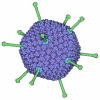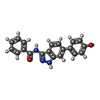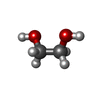[English] 日本語
 Yorodumi
Yorodumi- PDB-7ozd: FGFR1 kinase domain (residues 458-765) with mutations C488A, C584... -
+ Open data
Open data
- Basic information
Basic information
| Entry | Database: PDB / ID: 7ozd | ||||||
|---|---|---|---|---|---|---|---|
| Title | FGFR1 kinase domain (residues 458-765) with mutations C488A, C584S in complex with 34. | ||||||
 Components Components | Fibroblast growth factor receptor 1 | ||||||
 Keywords Keywords | TRANSFERASE / FGFR1 / Inhibitor / receptor tyrosine kinase | ||||||
| Function / homology |  Function and homology information Function and homology informationSignaling by FGFR1 amplification mutants / negative regulation of fibroblast growth factor production / positive regulation of mitotic cell cycle DNA replication / regulation of extrinsic apoptotic signaling pathway in absence of ligand / Signaling by plasma membrane FGFR1 fusions / diphosphate metabolic process / regulation of phosphate transport / regulation of lateral mesodermal cell fate specification / FGFR1c and Klotho ligand binding and activation / vitamin D3 metabolic process ...Signaling by FGFR1 amplification mutants / negative regulation of fibroblast growth factor production / positive regulation of mitotic cell cycle DNA replication / regulation of extrinsic apoptotic signaling pathway in absence of ligand / Signaling by plasma membrane FGFR1 fusions / diphosphate metabolic process / regulation of phosphate transport / regulation of lateral mesodermal cell fate specification / FGFR1c and Klotho ligand binding and activation / vitamin D3 metabolic process / cementum mineralization / positive regulation of MAPKKK cascade by fibroblast growth factor receptor signaling pathway / regulation of branching involved in salivary gland morphogenesis by mesenchymal-epithelial signaling / receptor-receptor interaction / response to sodium phosphate / auditory receptor cell development / fibroblast growth factor receptor signaling pathway involved in orbitofrontal cortex development / ventricular zone neuroblast division / Epithelial-Mesenchymal Transition (EMT) during gastrulation / chordate embryonic development / positive regulation of parathyroid hormone secretion / mesenchymal cell proliferation / paraxial mesoderm development / regulation of postsynaptic density assembly / FGFR1b ligand binding and activation / Signaling by activated point mutants of FGFR1 / FGFR1c ligand binding and activation / organ induction / Downstream signaling of activated FGFR1 / branching involved in salivary gland morphogenesis / Phospholipase C-mediated cascade: FGFR1 / positive regulation of phospholipase activity / lung-associated mesenchyme development / cell projection assembly / outer ear morphogenesis / embryonic limb morphogenesis / positive regulation of vascular endothelial cell proliferation / positive regulation of endothelial cell chemotaxis / skeletal system morphogenesis / positive regulation of mesenchymal cell proliferation / middle ear morphogenesis / ureteric bud development / cardiac muscle cell proliferation / inner ear morphogenesis / phosphatidylinositol-mediated signaling / PI-3K cascade:FGFR1 / midbrain development / Formation of paraxial mesoderm / positive regulation of stem cell proliferation / fibroblast growth factor binding / regulation of cell differentiation / PI3K Cascade / cellular response to fibroblast growth factor stimulus / fibroblast growth factor receptor signaling pathway / positive regulation of blood vessel endothelial cell migration / epithelial to mesenchymal transition / chondrocyte differentiation / calcium ion homeostasis / SHC-mediated cascade:FGFR1 / cell maturation / positive regulation of cardiac muscle cell proliferation / FRS-mediated FGFR1 signaling / Signaling by FGFR1 in disease / NCAM signaling for neurite out-growth / positive regulation of MAP kinase activity / positive regulation of neuron differentiation / SH2 domain binding / Signal transduction by L1 / stem cell proliferation / skeletal system development / positive regulation of cell differentiation / stem cell differentiation / sensory perception of sound / Negative regulation of FGFR1 signaling / placental growth factor receptor activity / insulin receptor activity / vascular endothelial growth factor receptor activity / hepatocyte growth factor receptor activity / macrophage colony-stimulating factor receptor activity / platelet-derived growth factor alpha-receptor activity / platelet-derived growth factor beta-receptor activity / stem cell factor receptor activity / boss receptor activity / protein tyrosine kinase collagen receptor activity / brain-derived neurotrophic factor receptor activity / transmembrane-ephrin receptor activity / GPI-linked ephrin receptor activity / epidermal growth factor receptor activity / fibroblast growth factor receptor activity / insulin-like growth factor receptor activity / receptor protein-tyrosine kinase / peptidyl-tyrosine phosphorylation / positive regulation of neuron projection development / neuron migration / neuron projection development / Constitutive Signaling by Aberrant PI3K in Cancer / MAPK cascade / cell migration / PIP3 activates AKT signaling / heparin binding Similarity search - Function | ||||||
| Biological species |  Homo sapiens (human) Homo sapiens (human) | ||||||
| Method |  X-RAY DIFFRACTION / X-RAY DIFFRACTION /  SYNCHROTRON / SYNCHROTRON /  MOLECULAR REPLACEMENT / Resolution: 1.82 Å MOLECULAR REPLACEMENT / Resolution: 1.82 Å | ||||||
 Authors Authors | Trinh, C.H. / Turner, L.D. / Fishwick, C.W.G. | ||||||
| Funding support |  United Kingdom, 1items United Kingdom, 1items
| ||||||
 Citation Citation |  Journal: J.Med.Chem. / Year: 2022 Journal: J.Med.Chem. / Year: 2022Title: From Fragment to Lead: De Novo Design and Development toward a Selective FGFR2 Inhibitor. Authors: Turner, L.D. / Trinh, C.H. / Hubball, R.A. / Orritt, K.M. / Lin, C.C. / Burns, J.E. / Knowles, M.A. / Fishwick, C.W.G. | ||||||
| History |
|
- Structure visualization
Structure visualization
| Structure viewer | Molecule:  Molmil Molmil Jmol/JSmol Jmol/JSmol |
|---|
- Downloads & links
Downloads & links
- Download
Download
| PDBx/mmCIF format |  7ozd.cif.gz 7ozd.cif.gz | 237.2 KB | Display |  PDBx/mmCIF format PDBx/mmCIF format |
|---|---|---|---|---|
| PDB format |  pdb7ozd.ent.gz pdb7ozd.ent.gz | Display |  PDB format PDB format | |
| PDBx/mmJSON format |  7ozd.json.gz 7ozd.json.gz | Tree view |  PDBx/mmJSON format PDBx/mmJSON format | |
| Others |  Other downloads Other downloads |
-Validation report
| Arichive directory |  https://data.pdbj.org/pub/pdb/validation_reports/oz/7ozd https://data.pdbj.org/pub/pdb/validation_reports/oz/7ozd ftp://data.pdbj.org/pub/pdb/validation_reports/oz/7ozd ftp://data.pdbj.org/pub/pdb/validation_reports/oz/7ozd | HTTPS FTP |
|---|
-Related structure data
| Related structure data |  7ozbC  7ozfC  7ozyC 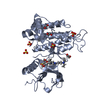 5a4cS S: Starting model for refinement C: citing same article ( |
|---|---|
| Similar structure data |
- Links
Links
- Assembly
Assembly
| Deposited unit | 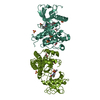
| ||||||||
|---|---|---|---|---|---|---|---|---|---|
| 1 | 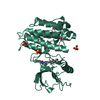
| ||||||||
| 2 | 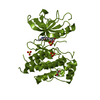
| ||||||||
| Unit cell |
|
- Components
Components
| #1: Protein | Mass: 35135.340 Da / Num. of mol.: 2 / Fragment: UNP residues 458-765 Source method: isolated from a genetically manipulated source Source: (gene. exp.)  Homo sapiens (human) / Gene: FGFR1, BFGFR, CEK, FGFBR, FLG, FLT2, HBGFR / Production host: Homo sapiens (human) / Gene: FGFR1, BFGFR, CEK, FGFBR, FLG, FLT2, HBGFR / Production host:  References: UniProt: P11362, receptor protein-tyrosine kinase #2: Chemical | #3: Chemical | ChemComp-SO4 / #4: Chemical | ChemComp-EDO / #5: Water | ChemComp-HOH / | Has ligand of interest | Y | |
|---|
-Experimental details
-Experiment
| Experiment | Method:  X-RAY DIFFRACTION / Number of used crystals: 1 X-RAY DIFFRACTION / Number of used crystals: 1 |
|---|
- Sample preparation
Sample preparation
| Crystal | Density Matthews: 2.67 Å3/Da / Density % sol: 53.92 % |
|---|---|
| Crystal grow | Temperature: 291 K / Method: vapor diffusion, sitting drop / pH: 6.7 Details: 0.185M ammonium sulfate, 20% v/v ethylene glycol, 17% w/v PEG 8000, 0.1M PCPT |
-Data collection
| Diffraction | Mean temperature: 100 K / Serial crystal experiment: N |
|---|---|
| Diffraction source | Source:  SYNCHROTRON / Site: SYNCHROTRON / Site:  Diamond Diamond  / Beamline: I04-1 / Wavelength: 0.9159 Å / Beamline: I04-1 / Wavelength: 0.9159 Å |
| Detector | Type: DECTRIS PILATUS 6M / Detector: PIXEL / Date: Jul 15, 2017 |
| Radiation | Protocol: SINGLE WAVELENGTH / Monochromatic (M) / Laue (L): M / Scattering type: x-ray |
| Radiation wavelength | Wavelength: 0.9159 Å / Relative weight: 1 |
| Reflection | Resolution: 1.82→22.01 Å / Num. obs: 66115 / % possible obs: 99.2 % / Redundancy: 3.4 % / CC1/2: 0.999 / Rmerge(I) obs: 0.03 / Rpim(I) all: 0.024 / Rrim(I) all: 0.035 / Net I/σ(I): 16.7 |
| Reflection shell | Resolution: 1.82→1.87 Å / Rmerge(I) obs: 0.836 / Num. unique obs: 4910 / CC1/2: 0.688 / Rpim(I) all: 0.598 / Rrim(I) all: 1.033 |
- Processing
Processing
| Software |
| |||||||||||||||||||||||||||||||||||||||||||||||||||||||||||||||||||||||||||||||||||||||||||||||||||||||||||||||||||||||||||||||||||||||||||||||||||||||||||||||||||||||||||||||||||||||||||||||||||||||||||||||||||||||||||||||||||||||
|---|---|---|---|---|---|---|---|---|---|---|---|---|---|---|---|---|---|---|---|---|---|---|---|---|---|---|---|---|---|---|---|---|---|---|---|---|---|---|---|---|---|---|---|---|---|---|---|---|---|---|---|---|---|---|---|---|---|---|---|---|---|---|---|---|---|---|---|---|---|---|---|---|---|---|---|---|---|---|---|---|---|---|---|---|---|---|---|---|---|---|---|---|---|---|---|---|---|---|---|---|---|---|---|---|---|---|---|---|---|---|---|---|---|---|---|---|---|---|---|---|---|---|---|---|---|---|---|---|---|---|---|---|---|---|---|---|---|---|---|---|---|---|---|---|---|---|---|---|---|---|---|---|---|---|---|---|---|---|---|---|---|---|---|---|---|---|---|---|---|---|---|---|---|---|---|---|---|---|---|---|---|---|---|---|---|---|---|---|---|---|---|---|---|---|---|---|---|---|---|---|---|---|---|---|---|---|---|---|---|---|---|---|---|---|---|---|---|---|---|---|---|---|---|---|---|---|---|---|---|---|---|---|
| Refinement | Method to determine structure:  MOLECULAR REPLACEMENT MOLECULAR REPLACEMENTStarting model: 5A4C Resolution: 1.82→22.01 Å / Cor.coef. Fo:Fc: 0.967 / Cor.coef. Fo:Fc free: 0.95 / SU B: 3.861 / SU ML: 0.11 / Cross valid method: FREE R-VALUE / ESU R: 0.122 / ESU R Free: 0.123 Details: Hydrogens have been added in their riding positions
| |||||||||||||||||||||||||||||||||||||||||||||||||||||||||||||||||||||||||||||||||||||||||||||||||||||||||||||||||||||||||||||||||||||||||||||||||||||||||||||||||||||||||||||||||||||||||||||||||||||||||||||||||||||||||||||||||||||||
| Solvent computation | Ion probe radii: 0.8 Å / Shrinkage radii: 0.8 Å / VDW probe radii: 1.2 Å / Solvent model: MASK BULK SOLVENT | |||||||||||||||||||||||||||||||||||||||||||||||||||||||||||||||||||||||||||||||||||||||||||||||||||||||||||||||||||||||||||||||||||||||||||||||||||||||||||||||||||||||||||||||||||||||||||||||||||||||||||||||||||||||||||||||||||||||
| Displacement parameters | Biso mean: 44.319 Å2
| |||||||||||||||||||||||||||||||||||||||||||||||||||||||||||||||||||||||||||||||||||||||||||||||||||||||||||||||||||||||||||||||||||||||||||||||||||||||||||||||||||||||||||||||||||||||||||||||||||||||||||||||||||||||||||||||||||||||
| Refinement step | Cycle: LAST / Resolution: 1.82→22.01 Å
| |||||||||||||||||||||||||||||||||||||||||||||||||||||||||||||||||||||||||||||||||||||||||||||||||||||||||||||||||||||||||||||||||||||||||||||||||||||||||||||||||||||||||||||||||||||||||||||||||||||||||||||||||||||||||||||||||||||||
| Refine LS restraints |
| |||||||||||||||||||||||||||||||||||||||||||||||||||||||||||||||||||||||||||||||||||||||||||||||||||||||||||||||||||||||||||||||||||||||||||||||||||||||||||||||||||||||||||||||||||||||||||||||||||||||||||||||||||||||||||||||||||||||
| LS refinement shell | Refine-ID: X-RAY DIFFRACTION / Total num. of bins used: 20
|
 Movie
Movie Controller
Controller


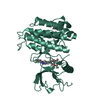
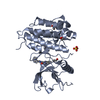


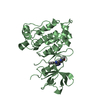
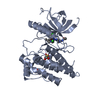
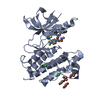
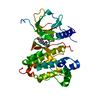
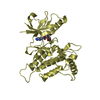
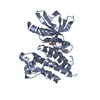
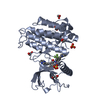
 PDBj
PDBj




